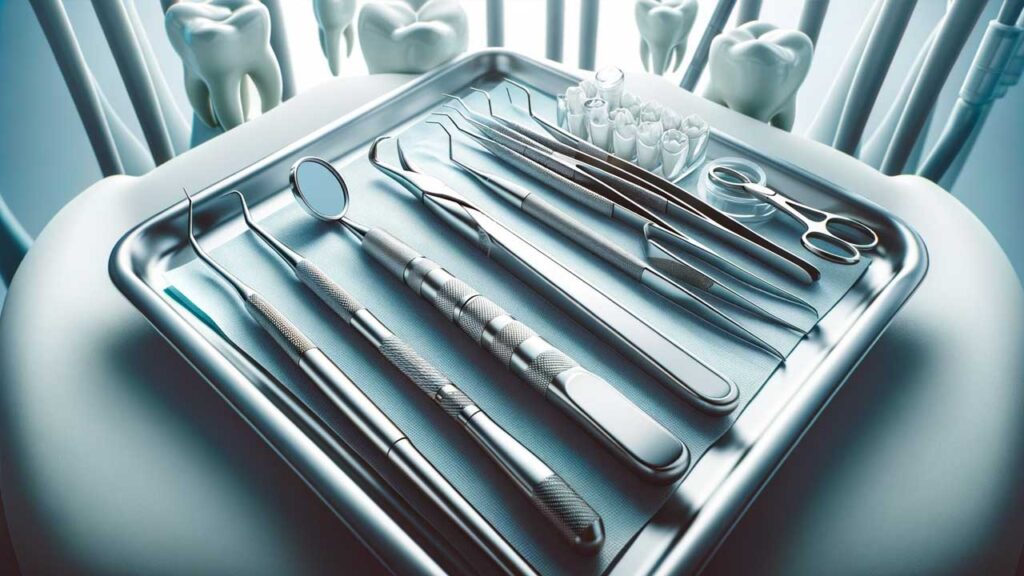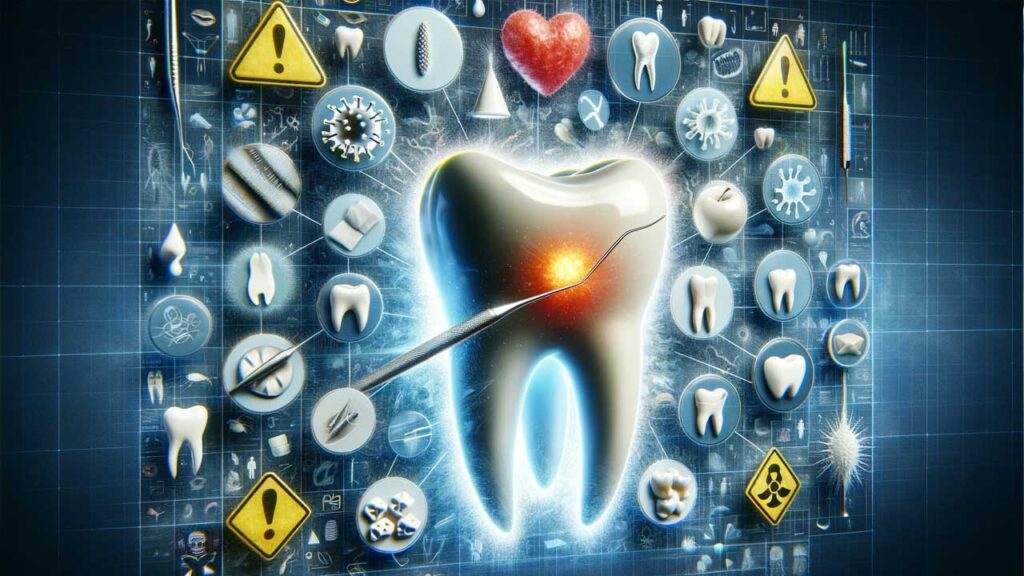When considering a tooth extraction, it’s crucial to ask: “What are the risks of tooth extraction?” This common dental procedure, necessary for various reasons like decay, overcrowding, or gum disease, does carry potential risks. Understanding these risks is a key step in preparing for the procedure and ensuring a safe recovery.
Tooth extraction involves the removal of a tooth from its socket in the jawbone. Though a standard dental procedure, it requires careful handling to minimize complications. The procedure’s nature and extent can vary, ranging from a simple extraction of a visible tooth to more complex cases such as impacted wisdom teeth.
The Importance of Knowing the Risks.
Awareness of the risks associated with tooth extraction is vital for patients. This knowledge helps in informed decision-making and setting realistic expectations. It also underscores the importance of following post-extraction care instructions to mitigate potential complications.
What Are the Risks of Tooth Extraction?

The risks of tooth extraction include immediate complications like bleeding, infection, and dry socket, as well as longer-term issues such as nerve damage or jawbone problems. It’s essential for patients to discuss these risks with their dentist and understand the necessary precautions and care.
Understanding Tooth Extraction Risks
Overview of Common Risks and Their Frequencies
| Risk Factor | Frequency | Description |
| Bleeding | Common | Typically lasts for a few hours post-extraction. |
| Infection | Less Common | Can occur at the extraction site, requiring antibiotics. |
| Dry Socket | 2-5% of cases | Blood clot fails to form, leading to pain and delayed healing. |
| Nerve Damage | Rare | Can result in numbness or altered sensation. |
| Jaw Damage | Very Rare | Includes fractures or injury to surrounding areas. |
Differentiating Between Minor and Major Risks
- Minor Risks: These include manageable issues like temporary bleeding and pain.
- Major Risks: More serious complications such as dry socket, infection, or nerve damage.
Statistics on Tooth Extraction Complications
- Bleeding and Pain: Experienced by a majority of patients, generally manageable.
- Dry Socket: Occurs in 2-5% of extractions, more common in wisdom tooth removals.
- Infection: Happens in a smaller percentage but requires prompt treatment.
Understanding these risks and their likelihood is crucial for patients undergoing tooth extractions. It helps in preparing for the procedure and in knowing what to expect during the recovery process.
Immediate Post-Extraction Risks
Bleeding After Tooth Removal
Bleeding is a common occurrence after tooth extraction and is usually no cause for alarm. It’s vital to manage it properly to prevent complications such as infections or prolonged healing times. Applying gentle pressure with a sterile gauze pad and avoiding strenuous activities are effective ways to control bleeding.
Pain Management Post-Extraction
Pain following tooth extraction is a natural part of the healing process. It’s important to manage this pain to ensure comfort during recovery. Over-the-counter pain relievers are commonly used, but in some cases, stronger prescription medication may be necessary. It’s crucial to follow the dentist’s recommendations and dosage instructions for any medication.
Swelling and Inflammation Control
Swelling is another common response to tooth extraction. To minimize swelling, ice packs can be applied to the cheek area intermittently. Keeping the head elevated, especially during sleep, can also help reduce swelling and promote faster healing.
Preventing Dry Socket
Dry socket, a condition where the blood clot at the extraction site gets dislodged, can cause significant pain and delay healing. To prevent this, patients are advised to avoid smoking, using straws, and engaging in activities that could disturb the extraction site. A soft diet is recommended for the first few days post-extraction.
Immediate Risk Management Strategies
| Risk Factor | Management Strategy | Additional Precautions |
| Bleeding | Gentle pressure with gauze; minimal activity | Avoid hot liquids, vigorous rinsing, and physical exertion for 24 hours |
| Pain | Over-the-counter or prescribed painkillers | Follow dentist’s instructions; avoid alcohol and smoking |
| Swelling | Ice packs; elevation of the head | Apply ice intermittently for the first 48 hours; avoid lying flat |
| Dry Socket | Avoid smoking and using straws; gentle oral hygiene | Soft diet; avoid disturbing the extraction site |
Infection Risks and Prevention
Post-Extraction Infection
Infection is a risk following tooth extraction, particularly if the wound is not properly cared for. This can manifest as severe pain, swelling, and sometimes fever. Maintaining good oral hygiene and following all post-extraction care instructions are vital in preventing infection.
Role of Antibiotics After Tooth Extraction
In some cases, especially for patients with a high risk of infection or those who have undergone complex extractions, antibiotics may be prescribed. It’s important to take these medications as directed to prevent infection at the extraction site.
Signs of Infection to Watch For
Key signs of infection include persistent pain that doesn’t subside with standard pain management, increased swelling, fever, and a foul taste in the mouth. If any of these symptoms occur, it’s crucial to contact a dentist immediately.
Oral Hygiene Practices to Prevent Infection
Effective oral hygiene practices, such as gentle brushing around the extraction site, rinsing with salt water, and using antiseptic mouthwash as recommended by the dentist, can significantly reduce the risk of infection.
Long-term Complications of Tooth Extraction
Jaw Damage from Extraction
Jaw damage, such as fractures or injury to the jawbone, can occur during tooth extraction, although it’s rare. This risk is higher in complex extractions, such as the removal of impacted wisdom teeth.
Nerve Damage in Tooth Extraction
Nerve damage is an uncommon but potential risk of tooth extraction, particularly in procedures involving the lower jaw. This can result in temporary or, in rare cases, permanent numbness or altered sensation.
Impact on Oral Health
Tooth extraction can have long-term effects on oral health, including the shifting of teeth, changes in bite, and potential for bone loss in the jaw. It’s important to discuss these potential issues with a dentist to understand the full implications of tooth extraction.
Periodontal Disease Post-Extraction
There is a risk of developing periodontal disease post-extraction if oral hygiene is not adequately maintained. Regular dental check-ups and proper oral care are essential in preventing this and other long-term complications.
Specific Risks in Wisdom Tooth Extraction
Wisdom Tooth Extraction Risks
Wisdom tooth extraction can present unique challenges and risks due to their position in the jaw and the possibility of impaction. Common risks include nerve damage, infection, and complications related to the close proximity to the sinus cavity in upper jaw extractions.
Impacted Wisdom Tooth Complications
Impacted wisdom teeth, which are teeth that haven’t fully erupted through the gum line, can lead to more complex extractions. This increases the likelihood of complications like severe pain, infection, and damage to adjacent teeth or bone.
Comparison of Risks in Wisdom Tooth vs. Regular Tooth Extraction
| Risk Factor | Wisdom Tooth Extraction | Regular Tooth Extraction |
| Infection | Higher due to impaction and complexity | Lower, with standard extractions |
| Nerve Damage | Higher, particularly for lower wisdom teeth | Less common |
| Bleeding | Can be more significant due to surgical extraction | Generally less severe |
| Recovery Time | Typically longer due to surgical nature | Shorter, with simpler procedures |
Risks for Special Patient Populations
Elderly Patients and Tooth Extraction
In elderly patients, tooth extraction can carry increased risks due to potential pre-existing health conditions, slower healing times, and possible interactions with medications.
Tooth Extraction in Diabetic Patients
For diabetic patients, there’s a heightened risk of infection and delayed healing. Blood sugar levels need to be well-controlled before and after the extraction to minimize complications.
Patients with Heart Conditions and Sedation Risks
Patients with heart conditions face additional risks, especially when sedation is used. It’s crucial for these patients to discuss their medical history with their dentist and anesthesiologist to ensure safe care.
Managing Complications Post-Extraction
Handling Bleeding and Infection
Post-extraction bleeding and infection are managed by following proper wound care, using prescribed medications, and maintaining good oral hygiene. If bleeding is severe or an infection is suspected, immediate dental consultation is necessary.
Treating Dry Socket and Alveolar Osteitis
Dry socket and alveolar osteitis require prompt treatment to reduce pain and promote healing. Treatment typically includes cleaning the socket and applying medicated dressings.
Addressing Jaw and Nerve Damage
Jaw and nerve damage, while rare, require specialized treatment. Management may include medications, physical therapy, or in severe cases, surgical intervention.
Post-Extraction Complication Management Techniques
| Complication | Management Technique | Preventative Measures |
| Bleeding | Pressure with gauze, rest | Avoid strenuous activities post-extraction |
| Infection | Antibiotics, proper wound care | Follow post-extraction cleaning instructions |
| Dry Socket | Dressing the socket, pain management | Avoid smoking and using straws |
| Nerve Damage | Medication, monitoring, possible referral | Careful surgical technique during extraction |
Recovery and Aftercare Post-Extraction
Dental Care after Extraction
Proper dental care post-extraction is essential for a smooth recovery. This includes gentle cleaning around the extraction site, avoiding disturbing the area, and following any specific care instructions provided by the dentist.
Recovery Time for Tooth Extraction
The recovery time can vary depending on the complexity of the extraction and individual healing processes. Typically, initial healing takes about one to two weeks, with complete recovery taking longer.
Effective Pain Relief after Tooth Removal
Pain management is key to a comfortable recovery. Over-the-counter pain relievers are usually sufficient, but in some cases, prescription medication may be necessary. It’s important to follow the dentist’s advice for pain management.
Dental Extraction Follow-Up Care
Follow-up care is crucial for monitoring healing and addressing any complications early. This may include appointments to check on the healing process and removal of any stitches if they were used.
Common Questions Associate with ‘Risks of Tooth Extraction’?
How to Reduce Infection Risk After Extraction?
Maintaining good oral hygiene and following the dentist’s instructions for care are the best ways to reduce the risk of infection after an extraction.
Signs of Complications After Wisdom Tooth Removal
Be aware of signs like excessive pain, swelling, prolonged bleeding, or signs of infection, which could indicate complications after wisdom tooth removal.
Managing Pain and Swelling Post-Surgery
Effective pain and swelling management include using prescribed painkillers, applying ice packs, and resting adequately after the surgery.
What to Do for Dry Socket Symptoms
If symptoms of dry socket – such as intense pain and visible bone in the extraction site – occur, contact your dentist immediately for appropriate treatment.
Long-Term Jaw Alignment Considerations
After tooth extraction, it’s important to consider the long-term impact on jaw alignment. Discuss with your dentist about potential future treatments like implants or bridges.
Impact of Oral Health on Extraction Risks
Good oral health can minimize the risks associated with tooth extraction. Regular check-ups and proper oral hygiene practices play a significant role in this regard.
In conclusion, understanding ‘What are the risks of tooth extraction?’ is crucial for anyone considering or undergoing this procedure. Awareness of potential complications, recovery expectations, and effective aftercare strategies is key to a successful outcome.
Professional dental care is essential not only for managing the risks associated with tooth extraction but also for providing guidance and support throughout the recovery process.
Maintaining ongoing dental health post-extraction is vital. Regular dental visits, good oral hygiene, and addressing any long-term implications of the extraction are important for overall oral health.

